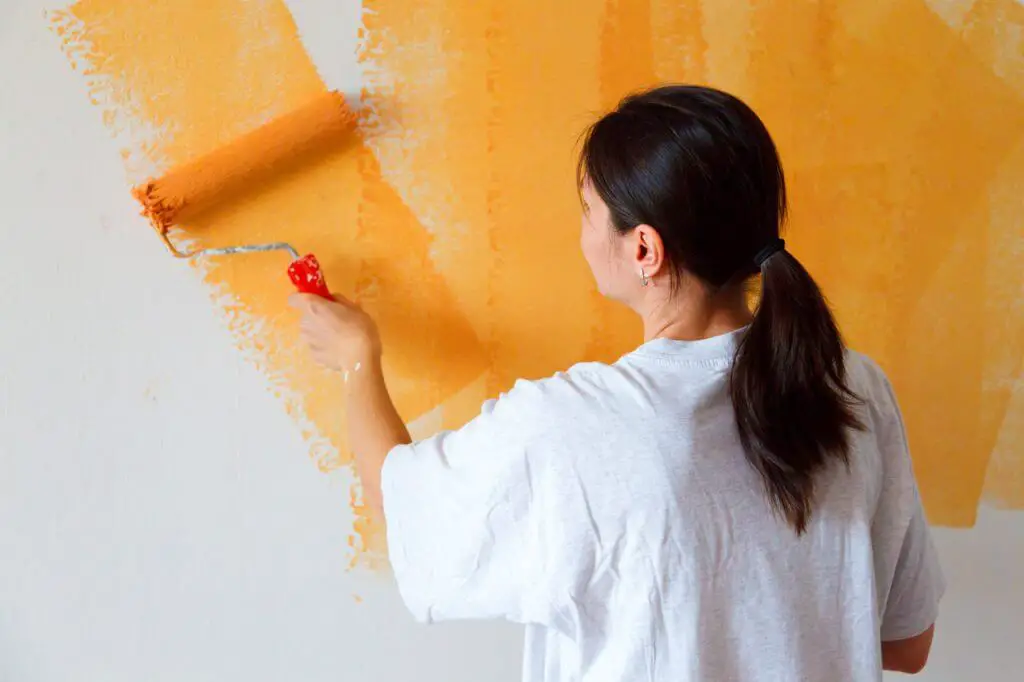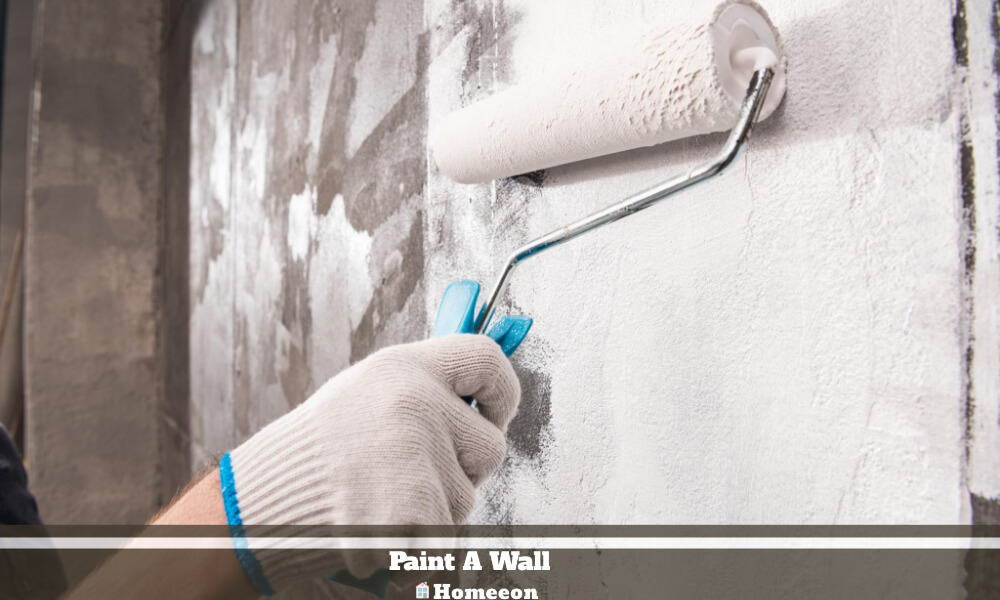Last Updated on August 2, 2023 By Emma W. Thomas
The number of times you should paint a wall depends on factors like color change, paint quality, and coverage. In most cases, applying two coats of paint is sufficient for a smooth and even finish.
Guidelines To Help You Know How Many Times Your Walls Need Painting

You may need to paint your walls at different intervals depending on the part of your home with these walls. These areas include;
Your Kitchen
Your kitchen is among the most used areas of a home. This place experiences a lot of steam, smoke, and grease splatter, which accumulates on the paint over time. You will need to repaint the kitchen after every four to five years to get rid of the build-up from odors and stains. Ensure that the walls are thoroughly cleaned before painting.
Hallways And Corridors
Your corridors and hallways experience the most traffic as compared to other parts of the home. They will therefore have a lot of scratches, dings, and scuff marks. For this reason, these areas require repainting every two to three years for your home to look great.
The Bedroom
Bedroom walls will need repainting depending on who occupies this space. For example, a kid’s bedroom will have a lot of crayon marks and other drawings. Make sure to paint these rooms as soon as they are old enough to stop using the walls as their drawing boards.
An adult’s bedroom and the guest room may go for many years without repainting and still look attractive. However, if you feel like getting a new look for your bedrooms and home, you can paint the walls as often as you want.
Your Baseboards And Trim
Your baseboards also experience a lot of traffic, just like the hallways. They get stains from vacuums, runaway toys, and also foot traffic. You will need to paint these areas every two to three years to keep your home attractive.
Your windows and door trim, as well as crown molding, do not require regular painting since they are not often used. If you don’t clean the areas regularly, dust and dirt will accumulate on the paint, thereby degrade it over time. You can add a fresh coat of paint as soon as the walls look unappealing to give them a better appearance.
Your Ceilings
Unless your room accumulates mold damage and water, the ceiling may not need periodic repainting. But, if you intend to repaint an entire room, be sure to add a fresh coat of paint to the ceiling. You may also need to repaint the ceiling if there is a discoloration that cannot go away after cleaning. You can use paint to remove any stain from smoke, such as that of a cigarette.
How Many Coats Of Paint Are Ideal For Walls?
You may be wondering how many coats are ideal for your walls, both in the interior and exterior of your home. A general rule is that you need two coats of paint, but this depends on the quality and color of the paint that you use. The type of surface you are painting and whether or not you use a primer also play a great role in determining the number of coats.
While it may cost more to apply two coats of paint than one coat, the wall will remain attractive for 3-5 years. But, high-quality paints may need only a single coat after primer. The number of coats on a wall will also depend on the surface and the area to be painted. For example, if your wall is new, follow the rule of two coats after primer, and this should also be the same case for drywall.
In case you are repainting a wall, a single coat will be enough if you are using the same color of quality paint.
How Many Coats Of Paint Does My Ceiling Need?
Your ceiling needs only one coat of high-quality paint after the primer application if you are using the same color. But, if the color has faded due to such factors as the sun, two coats of paint will be perfect.
If you are painting a dark color on top of a light one and vice versa, you are likely to need two coats of paint or more. Start with a small area to test whether one coat of primer and two coats of paint are enough.
How Many Coats Of Paint Does Your Exterior Need?
Your home’s exterior is normally exposed to multiple elements, including rain, sun, snow, birds, and insects. For this reason, the exterior requires at least two coats of paint to keep it looking great. Before painting the surface, you need to pressure wash it, clean it thoroughly, and apply primer. Doing this will help you prevent the paint from peeling off over time and give you a great finish.
What Are The Benefits Of Using Two Or Three Coats Of Paint?
While it may be costly to apply multiple coats of paint, there are some benefits of doing this which include;
Great Appearance
The application of more than one coat of paint leaves your surface looking nicer. Combining high-quality paint with more than one coat prevents your paint from peeling off, gives an even finish, and prevents the old coat from polluting the new look.
The Paint Lasts Longer.
A single coat of paint may not be as durable as two coats. Long-lasting paint means that you do not have to paint frequently, which eventually helps you save on maintenance costs.
Longer Warranty
The more coats of paint that you use, the longer your warranty on the task.
How To Apply The 2nd Coat Of Colored Paint On A Wall

A second coat of colored paint on interior walls helps to fill in thin streaks and spots and produces a uniform smooth coating that is more eye-catching than one coat. The second coat of paint (also known as the finish coat) is usually the last coating applied on a wall.
The following tips help in ensuring the success of the application;
Wait For The First Coat To Dry
While your walls may feel dry to the touch immediately after applying the first coat, you need to give it enough time before putting in a second coat. If you are using latex paint, you can wait for 2-4 hours before applying your second coat. But, if the paint is oil-based, it is advisable to wait for at least 24 hours before applying another coat.
Applying another coat of paint before the first one dries will cause the paint to pull up as you roll. If the paint pulls up, it will lead to peeling, streaks, and uneven color. If you give your first coat enough time to dry, it will be easier to see the parts with a second coat and which ones do not have since many colored paints are brighter when wet.
Cover Your Tools And Paint As You Wait
Ensure that as you wait for the first coat of paint to dry, your paints and tools are covered. You also need to clean the roller tray, cover the paintbrushes with plastic wrap and put them in the refrigerator until you use them later. Leaving the rollers and brushes uncovered may affect their efficiency in picking up paint which will also affect the outcome of the second coat.
Method Of Application
When applying the second coat of paint on your interior walls, follow the same procedure used when applying the first coat. You have to be careful to keep track of where you have painted. You can start at one top corner of the wall. Use an angled brush to cut in the corners and along the trim.
You will then need to roll the paint on in small parts in the shape of a 3-foot-wide and fill it in. Make sure that you paint an entire wall before moving to another to avoid skipping a part of the wall and then realizing it later.
Be Consistent
Make sure that you mix the paint regularly as you work to prevent streaks or variations in colors. Rich colors such as dark blue or red are made using many pigments that tend to settle at the bottom of the container if left to sit for a longer period.
You also need to be careful when mixing your paint to avoid getting different colors if you are using different cans. To avoid getting different shades, you can pour the paint into a large bucket and mix evenly.
Conclusion
You can apply two or more coats of paint to your walls, but this will depend on the quality and color of your paint. The type of surface and whether you will use a primer or not will affect the number of coats to use. It is, however, necessary to apply two coats of paint as a general rule for a better outcome.
References:
https://deltacitypainters.com/how-many-times-paint-wall/
https://marcpoulospainting.com/often-paint-wall-colors/
Emma is a graduate of Domestic Science or Family and Consumer Sciences (Home Economics) from the University of Wisconsin. She has 7 years of experience Working with the strategic section of BestBuy and now writing full-time for Homeeon.
From Managing the Home, Interiors, Cleaning, and Exteriors to Gardening and everything about Making A Home Liveable – is her passion and this Homeeon is the result of this.
Emma loves decorating her home with the best stuff found online. She cares about quality over anything and writes reviews about them here in Homeeon. Get in touch with her over Pinterest.
Keep reading her blogs.

